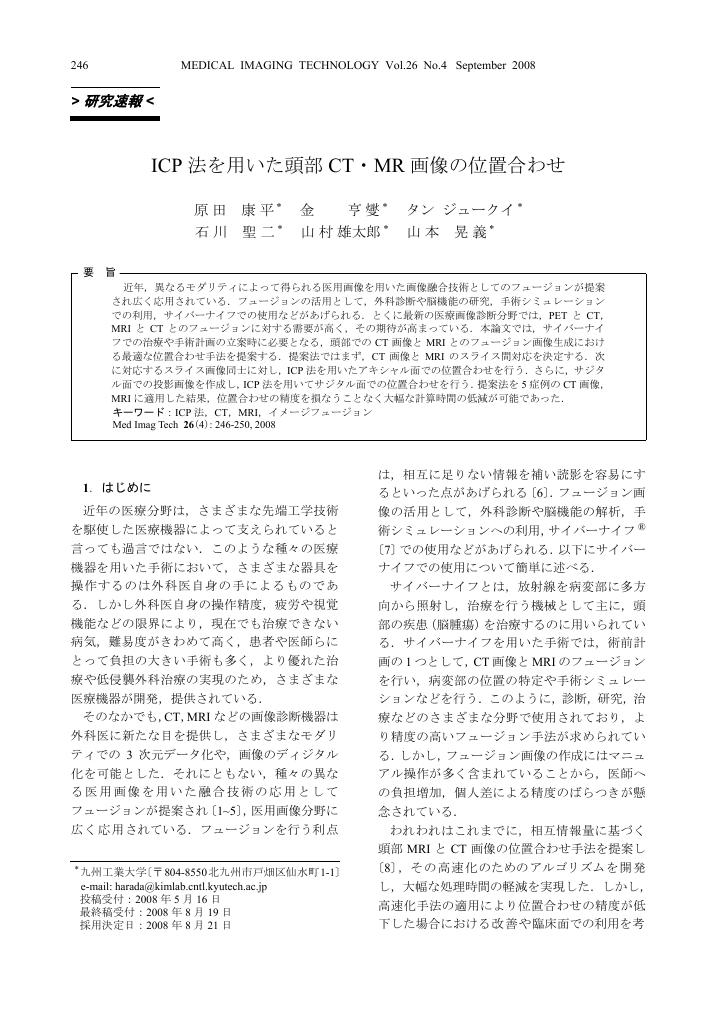1 0 0 0 OA ICP法を用いた頭部CT・MR画像の位置合わせ
- 著者
- 原田 康平 金 亨燮 タン ジュークイ 石川 聖二 山村 雄太郎 山本 晃義
- 出版者
- 日本医用画像工学会
- 雑誌
- Medical Imaging Technology (ISSN:0288450X)
- 巻号頁・発行日
- vol.26, no.4, pp.246, 2008 (Released:2016-02-17)
1 0 0 0 OA MEMS 慣性計測装置を用いた高精度リアルタイム補正音響測深システム
- 著者
- 丹 康弘 タン ジュークイ 石川 聖二
- 出版者
- 公益社団法人 日本船舶海洋工学会
- 雑誌
- 日本船舶海洋工学会論文集 (ISSN:18803717)
- 巻号頁・発行日
- vol.21, pp.75-81, 2015 (Released:2015-10-15)
- 参考文献数
- 17
This paper proposes a high-precision real-time correction sounding system using Micro Electro Mechanical Systems (MEMS) inertial measurement units, which can correct the effective depth from the sea surface to the seabed in real-time. The advantages of the proposed system are as follows: (1) The system outperforms a single-beam sounder available on the market in that the range of depth errors caused by the swing of a research vessel is about 2%: (2) Since the proposed system is small compared to the existing attitude and heading reference system, it can be employed for unmanned surface vehicle, remotely operated underwater vehicle, autonomous underwater vehicle, and so on. Experimental results show that an attitude, heading and depth measured by the developed system are within the acceptable range, and the system can give a stabilized attitude, heading and depth information for a long time.
1 0 0 0 人の動作の分割と認識のためのDMHI法
- 著者
- アハドアテイクルラハマン 緒方 健人 タンジュークイ 金亨蔓 石川 聖二
- 出版者
- 一般社団法人情報処理学会
- 雑誌
- 情報処理学会研究報告オーディオビジュアル複合情報処理(AVM) (ISSN:09196072)
- 巻号頁・発行日
- vol.2007, no.96, pp.55-60, 2007-09-26
本論文は,人動作認識法を提案する.提案法は,従来のモーションヒストリーイメージ法に対し,動作を複数方向に分割して複数のモーションヒストリーイメージを生成することにより動作認識を行う.このため,本法の特徴として,従来法では難しかった複雑な動作の認識が可能である.提案法をラジオ体操の認識に適用した.実験では複数の被験者にラジオ体操を行ってもらい,そのビデオデータから体操の種類を認識した.提案法によれば,演技者の巧拙にかかわらずよい認識率が得られた.提案法をさらに機能強化して知能ロボットに実装すれば,人の生活上のさまざまな動作・活動の認識が可能になり,荷物を持つ,転びそうになったら手を貸すなど,知能ロボットによる人の行動・活動支援も将来可能になる.Motion separation and recognition within a video sequence is one of the most challenging problems. This paper describes a new method of separating simple human motion by employing four-directional motion history images, called DMHI. It also covers human motion recognition utilizing DMHI technique. Four partial motion history images are created by exploiting the concept of Efros et.al.'s motion descriptors. The optical flow is separated into four components based on the four directions, namely, up, down, left and right. Based on this separation, four motion history images are developed and the corresponding brightness-levels are simultaneously integrated to decide the motion separation based on the four direction. The implementation results show that this new approach can separate motion promptly and properly.
